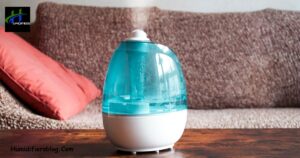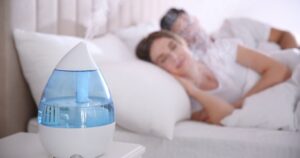The process of humidifying a room generally requires several hours, contingent on room size. Smaller rooms tend to reach optimal humidity faster compared to larger spaces during this process.
Ever wondered, How long does it take to humidify a room? Find out now! Dive into the secrets of quick room moisture with our insightful guide. Discover the perfect duration for your space, ensuring comfort and a healthier living environment.
Humidifying a room is a process that takes time, influenced by room size and humidifier strength. Smaller rooms tend to get moist faster than larger ones. The efficiency of your humidifier is crucial for optimal results. Understand these factors, and you’ll master the art of creating a comfortable living space.
Humidifier Capacity
Humidifier capacity is a key player in maintaining ideal moisture levels at home. Tailoring the humidifier size to your room’s dimensions is crucial; for larger spaces, opt for higher capacity to ensure consistent humidity distribution. This simple adjustment ensures that every nook and cranny of your living space benefits from the optimal moisture, promoting a healthier and more comfortable environment.
Understanding humidifier capacity is like customizing comfort. It’s not just about size; it’s about choosing a capacity that aligns with your room dimensions. Whether it’s a cozy bedroom or a spacious living area, the right humidifier capacity ensures that you experience the soothing effects of balanced humidity, enhancing your overall well-being.
The Science Behind Humidification
Humidification is the science of adding moisture to the air. Humidifiers do this job, making dry air comfy. They release water vapor, balancing humidity levels. This helps prevent dry skin, irritated eyes, and even snoring.
In the process, humidifiers tackle static electricity. They’re like the unsung heroes in creating a cozy, healthy indoor environment. Understanding this science unveils the secret behind a more comfortable living space.
| Aspect | Explanation |
| Relative Humidity (RH) | The amount of moisture in the air expressed as a percentage. |
| Evaporation | The amount of moisture in the air is expressed as a percentage. |
| Condensation | Water molecules transition from liquid to vapor to increase RH. |
| Humidistat | Vapor turns back into liquid, releasing heat and increasing RH. |
| Health Impact | Proper humidification can alleviate respiratory and skin issues. |
| Temperature Influence | Warmer air can hold more moisture, affecting RH levels in a space. |
| Hygrometer | Instrument measuring RH levels for humidity control assessment. |
Humidity and Health
Humidity affects health in surprising ways. Balanced moisture levels keep your skin happy, preventing dryness. They also help your respiratory system, making it easier to breathe. When the air is too dry, it can lead to discomfort and health issues.
On the flip side, excessive humidity isn’t a friend either. Too much moisture can create a breeding ground for mold and dust mites, triggering allergies. Maintaining the right humidity balance is key to a healthy and comfortable living environment.
Room Size Matters

Consider your room size when embracing humidifiers. For smaller spaces, compact units work wonders. They efficiently hydrate the air, creating a cozy environment. In larger rooms, opt for more powerful humidifiers to cover the space effectively. Size matters in keeping your air just right.
Don’t overlook the importance of room dimensions. A well-chosen humidifier caters to your space. Compact ones suit smaller rooms, ensuring optimal humidity. For larger areas, pick a robust humidifier to evenly disperse moisture. Tailor your choice to your room size for maximum comfort. Cold or hot water in humidifier may affect its performance, so choose wisely.
Ideal Humidity Levels
Ideal humidity is like a Goldilocks zone for your comfort. Not too dry, not too damp—just right. It sits around 40-60%, making your space feel cozy. At this level, you breathe easy, sleep better, and your skin stays happy.
When the humidity’s too low, things get dry and scratchy. Your nose feels like a desert, and your skin starts craving moisture. But if it’s too high, dampness takes over. Cue discomfort, mold, and that sticky feeling. Stick to that sweet spot, and your surroundings become a haven of comfort.
Factors Affecting Humidification Time
Firstly, room size matters. A larger space takes more time to humidify. Secondly, the humidifier’s capacity is crucial. A higher capacity means quicker moisture release. Additionally, external factors like ventilation affect the process. Keep these factors in mind for efficient humidification.
Also, consider the humidity level. If it’s very low, expect a longer time. Furthermore, the room’s starting moisture matters. Dry rooms need more time for humidification. Keep an eye on these factors to optimize your humidification time and enjoy a comfortable atmosphere.
The Role of Climate
Climate shapes our surroundings. It dictates whether we need jackets or sunscreen. When it comes to air quality, climate plays a part too. Humidifiers prove useful in both dry and smoky conditions, adapting to the climate’s demands.
In hot climates, dry air is a common gripe. Humidifiers step in, offering relief by adding moisture. Conversely, during smoky days, these trusty companions continue their role, helping combat the discomfort caused by smoke-laden air. Understanding climate’s influence helps us appreciate the versatility of humidifiers in creating a comfortable atmosphere.
Smart Humidification Solutions
Smart humidification is a game-changer. These devices adjust moisture levels automatically, keeping your air just right. No need to stress about dryness or excess humidity, it’s like having a humidity superhero at your service.
With smart humidifiers, you’re in control. Set preferences with ease using intuitive controls. They sync seamlessly with your lifestyle, making comfort effortless. Smart humidification – the modern solution for a perfectly balanced atmosphere.
Balancing Act Humidity vs. Energy Consumption

Balancing humidity without burning through energy is a smart game. Humidifiers bring comfort, but excessive use can spike energy bills. Optimal humidity helps without the unnecessary power struggle. Find your sweet spot for a cozy and cost-efficient atmosphere.
Strike a balance between take to humidify a room humidity and energy consumption. Too much humidity strains energy, but too little affects comfort. Humidifiers, when used wisely, maintain a Goldilocks zone. Enjoy the comfort without compromising your energy budget.
Frequently Asked Questions
Do you run a humidifier all night?
Yes, running a humidifier all night can maintain optimal humidity levels for improved sleep and respiratory comfort. Ensure proper maintenance to avoid over-humidifying the room.
How can I tell if my humidifier is working?
Feel the air, moisturized air feels less dry on your skin. Check for condensation on windows; if it’s there, your humidifier is at work.
How long does it take for a humidifier to help dry skin?
A humidifier can begin relieving dry skin within a few hours by adding moisture to the air. Consistent use over a few days often shows noticeable improvements in skin hydration.
How long does it take a humidifier to fill the room?
A humidifier typically takes a few hours to fill a room with increased moisture, depending on its size and capacity. Larger humidifiers can cover more space faster than smaller ones.
Conclusion
In conclusion, humidifiers are your go-to pals for comfortable living. They effortlessly tackle dry air, making breathing a breeze. When smoke clouds the air, these humble devices step in, easing discomfort.
It’s crucial to strike a balance to avoid unnecessary energy strain. Find that sweet spot, and let your humidifier create a cozy, welcoming atmosphere. It’s the small, steady steps that lead to a breath of fresh air in your home.










